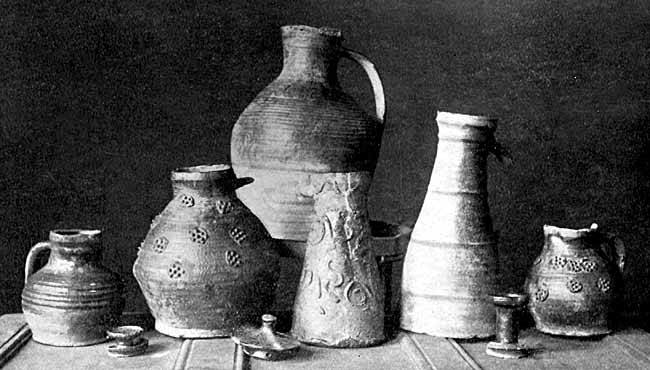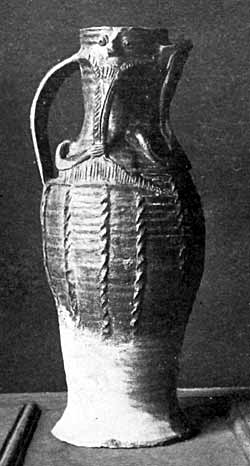Ancient Nottingham Pottery
By R. A. Wilde.

GROUP OF POTTERY FOUND IN NOTTINGHAM.
SEVERAL objects of antiquarian interest were discovered in connexion with the construction of the Manchester, Sheffield & Lincolnshire Railway Company's new London line (now the Great Central) through Nottingham. The excavation for the Victoria Station necessitated the removal of about half a million cubic yards of the soft yellow Bunter sandstone rock, on which a large portion of the city is built; and in April, 1897, during the removal of the southern portion (where Parliament Street crosses the railway), the old town wall was cut through. This was described by the late Mr. James Shipman, F.G.S., in a very able and interesting series of articles, published in the 1897 and 1898 volumes of "Notts, and Derbyshire Notes and Queries" (Murray, Nottingham). It was near this point, and at a depth of from ten to twelve feet beneath the original surface, that a long buried treasure was brought to light, in the shape of an ancient pattery kiln. This discovery at the time aroused great interest among local antiquaries, and is described by Mr. Shipman in an addendum to the reprinted "Notes on the Old Town Wall" (also published by Murray). With this exception, however, I have not been able to discover any printed description of it, or any theory as regards its age, and this article is designed to furnish such details, and to describe what is probably an almost unique discovery. The credit of rescuing from destruction by ruthless navvies the many specimens which were found, belongs largely to Mr. C. B. Wright, of the late firm of I. & I. C. Wright & Co., Bankers, who has also devoted a vast amount of patience and ingenuity to collecting and piecing together many broken parts; in some cases as many as thirty or forty fragments being cemented together to form one complete specimen; in others, missing parts being shaped and fitted. By his courtesy, I was enabled to examine and discuss with him his collection, and he very generously presented me with about a dozen more or less perfect or unbroken specimens of various shapes and sizes. These were forwarded to the General Manager of the Railway, Mr., now Sir William Pollitt, who has taken great interest in these treasures.
For the most part, they consisted of what were evidently jugs for carrying water, ale, mead, or wine, stew jars and drinking vessels, and a close examination reveals many peculiar characteristics. They are made of coarse clay, reddish brown in colour, and bear evidence of the use of the potter's wheel. They show no kind of ornamentation, except that the handles are indented or grooved the whole length at each side, and more deeply in the centre, by the potter's thumb, presenting a very crude attempt at foliation. Where the upper portion of the handle joins the jug, the indentation in the centre is made very much deeper, in order to afford a stronger grip. In some cases the grooves are very much narrower than in others, suggesting the theory that they were formed by women and children. One peculiarity is, that all the jugs are covered on the upper and outside portion only, with a dark greenish glaze, with occasional accidental splashes on the unglazed portions. One is led to wonder why the upper external surface only is glazed, where the glaze appears practically useless, as the unglazed portions are very rough and porous, perhaps with age. Three specimen jugs are here illustrated.

The largest of these is seventeen inches high and twelve inches in diameter, and intended to hold about two gallons, but as a matter of fact, like many of the others, it would not hold anything of a liquid nature, as with a singular lack of ingenuity or thoughtfulness on the workmen's part, or perhaps to save space, they were placed in the kiln, not on shelves, or protected in any way, but with the base of the upper row resting on the mouth of the lower one, having been so placed whilst the clay was in a soft condition; this caused the base of those on the upper tiers to be more or less damaged, many being quite broken through, others bearing the impress of the mouth of the jugs below, while the glazing of those in the lower row was torn away from the mouth when the vessels came to be detached from one another. The bottom row was laid on three or four small dabs of clay.
It is very interesting to note that although no complete specimen has been discovered, with any device or ornamentation beyond the thumb marks before mentioned, yet many fragments were found bearing what were possibly intended for marks of ownership, or the badges of the various families in the vicinity. One resembles a hammer, nail and a curved figure. Another device or mark bears a slight resemblance to "I.H.S." The characters, however, are so roughly shaped that their meaning can only be surmised. One shows distinctly the figure of a buckle. All these designs were put on while the jugs were in a soft condition, no attempt being made to protect them, so that the sides are thrust inward where the device appears. They were made by placing a small piece of soft clay on the jug, the imprint being fixed on with a stick, at one end of which the design was carved, precisely in the same way as we seal letters.
Several loose lids were found, all of the same size, and, generally speaking, although the jugs vary in size and shape, the mouths are uniform, the lids thus fitting each; several specimens were slender, evidently being intended for drinking cups.
The chief interest in the pottery, however, consists in trying to identify the period during which it was manufactured, and its probable rarity, and it is hoped that this article may throw some light on it. In the "Art Journal" for 1864, Professor Llewellyn Jewitt, F.S.A., contributes a long and elaborately illustrated article on the Ancient Potteries of the Midland Counties, in which he explains that the potteries of England are divided into the Celtic or Ancient British, Romano - British, Anglo - Saxon, Mediaeval, and Modern. It may simplify matters to say at once that the pottery found at Nottingham cannot be included in either of the first three periods named, for the potter's wheel was not known to the Ancient British, and their pottery was in consequence extremely thick and roughly made. It is a singular fact that no Roman remains of any description have ever been discovered in Nottingham, the nearest being at Southwell and Barton-in-Fabis. Professor Jewitt states that although single specimens of Roman pottery are not uncommon, no kiln has ever been discovered in England, adding that the Saxons had a great dislike to clay for culinary, or for drinking and food vessels, the last being made of ash or metal, and their drinking cups of horn or glass. Some of their later pottery, however, presumably urns, etc., shews signs of the potter's wheel.
We now come to the Mediaeval age, but as this covers a rather wide period, in which Saxon and Norman work overlap, it may be better to confine ourselves to the latter. On page 338 of the "Art Journal," Professor Jewitt describes specimens which, in both the text and illustrations, coincide to the minutest detail with those now under discussion, including the nature of the clay, the use of the potter's wheel, the partial glazing of dark green, and the foliation of the handle. These, he asserts, are of Anglo-Norman manufacture. Up to the time of his writing (1864) only one pottery of either Anglo-Saxon or Anglo-Norman date had been discovered in England, and this one he himself found in the county of Derby. Therefore, on the assumption that the Nottingham kiln is the second (a matter, however, difficult to prove), it gains greatly in interest and importance. In any case it is evident that such discoveries are of extreme rarity.
